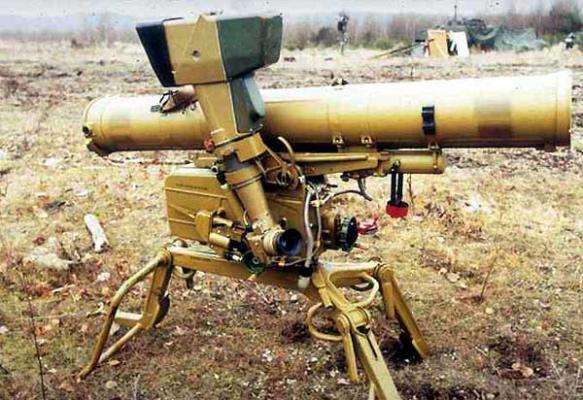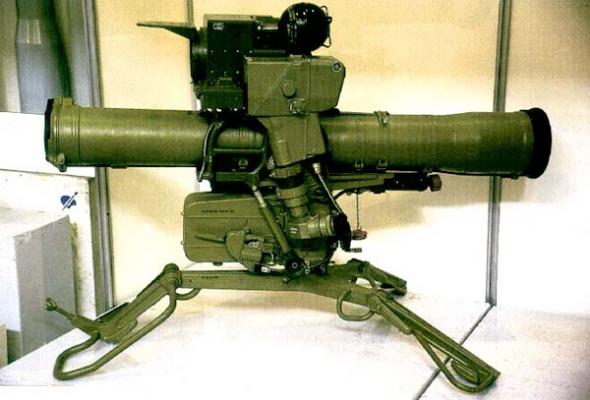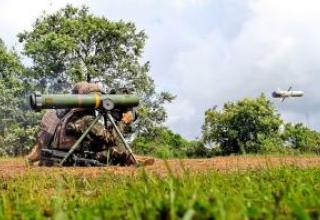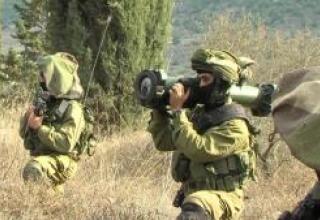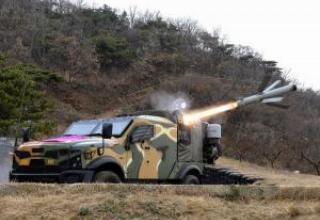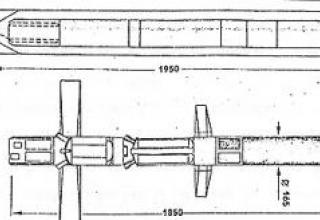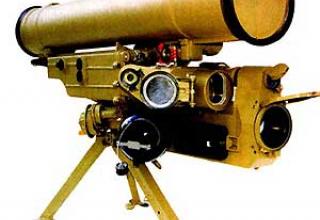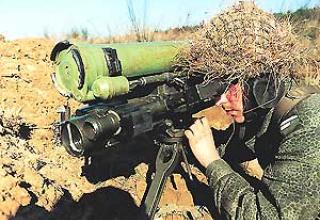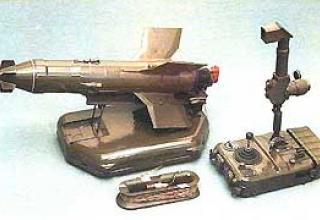Portable antitank complex 9K111 "Fagot" is designed to engage tanks and other armored targets, as well as helicopters and firing points of the enemy.
The development of the Fagot anti-tank complex began in March 1963 at the Instrument-Making Design Bureau (Tula). The full-scale development of Fagot was started by the decision of the Commission on Military and Industrial Issues under the USSR Council of Ministers dated May 18, 1966 under No 119.
Factory tests of the complex, conducted in 1967-1968, were unsuccessful. The last stage of factory tests was started in January 1969, but due to low reliability of the wire line the tests were stopped again. Once the faults were corrected, they were completed in April-May 1969. And in March 1970 joint (state) tests of the complex were finished. By CM Decision No. 793-259 of 22 September 1970, the Fagot complex was adopted for service. In 1970 the installation lot "Fagot" (100 pieces) was ordered to Kirov factory "Mayak", and the next year their mass production started there. Production of "Fahogot" at the plant "Mayak" was debugged in the IV quarter of 1971, when 710 shells were delivered. In 1975, an upgraded version of the 9M111M rocket with extended range and increased armor penetration was created. The upgraded model of the complex was named 9M111M "Faktoria".
The 9K111 Fagot was exported to many countries and used in many local conflicts of the last decades. Besides Russia, the complex of different modifications is in service with land forces of Afghanistan, Bulgaria, Hungary, India, Jordan, Iran, North Korea, Kuwait, Libya, Nicaragua, Peru, Poland, Romania, Syria, Vietnam, Finland.
In the west, it was designated AT-4 "Spigot".
Composition:
The complex 9K111 "Fagot" includes:
- folding portable launcher 9П135 (9П135М, 9П135М-1) with 9С451 control equipment, 9Ш119М1 missile guidance device and 9П155 launch mechanism on 9П56 (9П56М) machine tool
- 9M111(9M111-2) missiles in transport and launch containers (see figure);
- ZIP .
- test equipment and other auxiliary equipment
The 9P135M-1 launcher (PU) is designed to point 9M111, 9M111-2, 9M111M and 9M113 missiles. The PU 9P135M-1 consists of the 9P56M machine tool, the 9Sh119M1 device, the 9C474-1 hardware unit and the 9P135.01.000 starter mechanism connected by a cable.
Rocket 9M111 has an aerodynamic scheme "duck" - in the nose section are installed aerodynamic rudders with electromagnetic drive, in the tail - opening after the start of the bearing surfaces (layout scheme). Wing consoles were made of thin sheets of stainless steel. The flexibility of these sheets made it possible to roll the consoles around the missile body before loading into the transport and launch container. After leaving the container, the consoles themselves open under the force of elasticity. The "duck" scheme had not been used in PTURS before, because the steering unit interfered with the action of the gas jet of cumulative charge and, accordingly, the armor permeability decreased. A non-standard solution was found: the steering drive unit was located in the head end within the focal distance of the cumulative charge, and at the moment of projectile impact on the armor there was a shift of the steering drive relative to the projectile axis. This not only simplified the projectile, but also made it possible to reduce its length by partially filling the usually free space in front of the combat unit.
The 9M111 missile is equipped with a single-chamber single-chamber propulsion system. Its combination with the embossing propulsion system optimally solved the issue of accurate projectile exit into the field of view of control equipment. The missile is equipped with a cumulative warhead and is delivered in an airtight transport and launch container.
In complex 9K111 used semi-automatic pointing the missile at the target - control commands are transmitted to the missile via wires. When the complex is used in combat, the gunner points to the target and after the launch the missile is automatically brought to the sighting line. In flight, the missile is stabilized by rotation and controlled by the deviation of the nose rudders on the signals of ground control equipment, transmitted from the PU on the wire line of communication. In the tail part there is a reel with a wire and a headlight lamp with a mirror reflector. When the bouncer motor is triggered, the reflector and the lamp are protected by curtains that are opened after the rocket leaves the container. At the same time, the bouncing charge combustion products heat up the reflector mirror, eliminating the possibility of misting at low temperatures. The lamp is varnished, which prevents the operator from being blinded in low light. The control system also includes a gyroscopic device, equipment for receiving commands coming from the wire line.
The machine consists of a tripod, swivel, lifting and turning mechanisms. Screw-lift mechanism provides an angle of vertical guidance from -20° to +20° The swivel mechanism allows circular firing, and if necessary the swivel can be rotated manually. The container is a fibreglass tube with removable back and front lids. The design of the supports allows for adjustment of the height of the firing line and allows folding in the hiking position, while the supports, together with the tubular handrails, form the fence of the swivel, cradle, sight and control unit and take over the mechanical effects. A simple gearbox has been developed for installation, providing easy and smooth guidance of the unit in two modes (for low-movement and high-speed purposes), with an inertial mechanism that eliminates jerks in guidance. In the process of development of the bouncing motor unit, which provides the projectile velocity about 75 m/sec, the task of PU stability at firing was solved by achieving dynamic equilibrium within 2 kgf, which is no more than 3.5 and 1.7% of the total impulse received at firing of "Fagot" and "Contest" projectiles, respectively. This made it possible to use PU with the simplest shock-absorbing devices and to ensure the possibility of firing from any ground and in deep snow from skis, with the projectile flight control starting almost immediately after its exit from the TIC. The complex has successfully solved the task of launching the projectile automation: the operator only presses the trigger, and subsequent operations - the release of the equipment to the mode, opening the container lid, the start of the projectile - are done automatically without its participation.
Device 9Ш119М1 receives the radiation of the lamp and determines the position of the projectile in flight relative to the line of sight. The 9C469MZ Light Interference Indicator is intended for issuing a warning signal to the operator about the presence of 9Sh119M1 Light Interference in the field of vision of the 9K111 Instrument. The weight of the starting device is 22.5 kg. Speed of fire - 3 shots per minute. Starting device 9П135 and its modification 9П135М are easily disassembled. For example, BMP-2 and BMD-2 have launch guides mounted on the turret, while the control devices are mounted inside the combat compartment. A tripod is also placed on the left side of the turret in a folded state. If necessary, two members of the BMP-2 or BMD-2 crew can easily move the Fagot complex from the machine version to the remote one. In the machine version the angle of vertical guidance of the starting device 9P135 from -5 ° to +15 °. PTURS number - 4.
The 9M111M, 9M113, 9M113M rockets of "Faktoria", "Contest", "Contest-M" complexes can also be used from 9P135 (9P135M) launchers. After adoption for service with the "Contest" complex, the 9M111 missiles are also used from combat vehicles 9P148 of this complex.
The complex is easy to operate, relatively easy and can be carried by two people. Weight of the loader N1 commander calculation with the launcher is 22.5 kg. The second calculation number is 26.85 kg loader N2 with two missiles in the TIC.
The disadvantage of the complex is the possibility of hitting the target only if it is visually visible. The missile has a conventional (not tandem) cumulative BC and can not hit the armored vehicles equipped with dynamic protection.
Characteristics:
| 9М111 | 9М111М | |
| Range of fire, m | 70 - 2000 | 75 - 2500 |
| Speed, gunshot/min. | 3 | 3 |
| Average rocket speed, m/s | 186 | 180 |
| Maximum flight speed, m/s | 240 | 240 |
| Flight time at maximum range, sec | 11 | 13.5 |
| Overall dimensions, mm: - calibre (case diameter) - length - wingspan |
120 863 369 |
120 910 369 |
| The dimensions of the container, mm: - length - width - altitude |
1098 150 205 |
1098 150 205 |
| Mass of the rocket, kg: - in TPK - TPK-free |
13 13.2 |
11.3 11.5 |
| Weight of combat unit | 2.5 | 2.5 |
| Armor-piermeable, mm | 400 | 460-500 |
| Armour-piermeable (at 60°), mm | 200 | 230 |
Testing:
The Exocet was first used on May 4, 1982 during the Falkland Islands War. On that day, an Argentine patrol aircraft "Neptune" at a distance of about 200 km found compounds of British ships. From Rio Grande Air Base, located at a distance of about 850 km, 5 attack aircraft "Super Etandar". Only 2 of them carried one anti-ship missile "Exocet" under the right console, and under the left console - a dumpable fuel tank with a capacity of 1100l. One aircraft with the same weapons was backed up, while the other two carried only the fuel tanks, acting as refuelers. Stormtroopers were going at an altitude of 50 m above sea level. At 46 km from the ships the pilots increased the altitude up to 150 m, made a short time, by 30 seconds, activation of on-board radars. On the screens of the indicators highlighted the marks of two targets: the destroyer URO "Sheffield" and frigate "Plymouth". The angle between the directions on them was 40 °. After entering data on each target at a distance of 37 km was launched two missiles "Exocet". At the time of launch, the onboard warning systems informed pilots about the illumination of the aircraft by the Plymouth frigate radar station. Sheffield's search radar was turned off to eliminate interference with Skynet's satellite communications system, through which negotiations were conducted with London. The aircraft immediately withdrew from the Sea Dart SAM system, which was armed with British Sheffield type destroyers. Active radar homing head of one of the missiles captured Sheffield at a distance of 12-15 km, the height of its flight dropped to 2-3 m. Visually, the missile was spotted only 6 seconds before hitting the ship. The rocket broke through the board 1.8m above the waterline, but inside the hull did not explode - did not trigger a contact delayed action fuse. The remnants of the rocket fuel ignited the electric cables and the paint. The compartment was quickly filled with toxic smoke and there was a real threat of missile and artillery ammunition explosions. After five hours of unsuccessful fight against the fire, the crew left the ship. The second missile from frigate "Plymouth" was discovered in advance - 40 seconds. A curtain of dipole reflectors created passive interference, which increased the missile in the wrong direction.
The largest ship, sunk by a guided missile after 1945, was the British air transport "Atlantic Conveyor", converted before the war from a civilian container ship. On 25 May, a pair of Super Etandar aircraft took off from the airbase in Rio Grande and headed north-east, then turned east, refueled from the C-130 aircraft and went south and then west to the aircraft carrier's manoeuvring area at an altitude of 30 m from the side with which the attack was least expected. Pointing the target was made from C-130 aircraft. On distance of 80 km from a prospective location of connection the Argentine pilots have found the aircraft carrier "Hermes" in an environment of other ships. Having launched the rocket from a distance of 48 km from the target, the aircraft immediately went towards the continent at extremely low altitude. At this time, the British from the ships and helicopters lifted into the air put obstacles - dipole reflectors. Disoriented by interference missiles captured the aircraft carrier "Atlantic Conveyor" located 6 km away and sunk it, along with 15 helicopters on board Wessex and Chinook.
On 30 May, the Super Etandar launched two Exocet rockets against the British aircraft carrier, the Invincible. Security ships and helicopters placed curtains in the form of clouds of dipole reflectors, as a result of which both missiles went off course and fell into the sea.
On May 17, 1987, an Iraqi Mirage fighter jet fired two Exocet missiles at the American frigate Stark. Both missiles hit the frigate, but only one exploded. However, the frigate was badly damaged. American experts noted that if it were in the stormy Atlantic and not in the calm in the Persian Gulf, the frigate would have inevitably sunk.
Sources:
- "Российское ракетное оружие 1943-1993", А.В. Карпенко, СПб,"Пика", 1993
- "ПТУРы сухопутных войск", Серия "Архив 500+" Киев, "Архив-Пресс",1997 г.
- Переносный противотанковый комплекс 9К111. Техническое описание и инструкция по эксплуатации (для расчета) 9К111.00.00.000 ДТО, 1990 г. - С.4,6. (Смотрите электронный вариант издания).
- Пусковая установка 9П135М. Техническое описание 9П135М.00.000ТО. - С.4,5.
- Военный Парад
- FAS - www.fas.org
- Bharat-Rakshak - www.bharat-rakshak.com
- Р.Д.Ангельский "Отечественные противотанковые комплексы" -М: ООО "Издательство Астрель", 2002,-192с.
